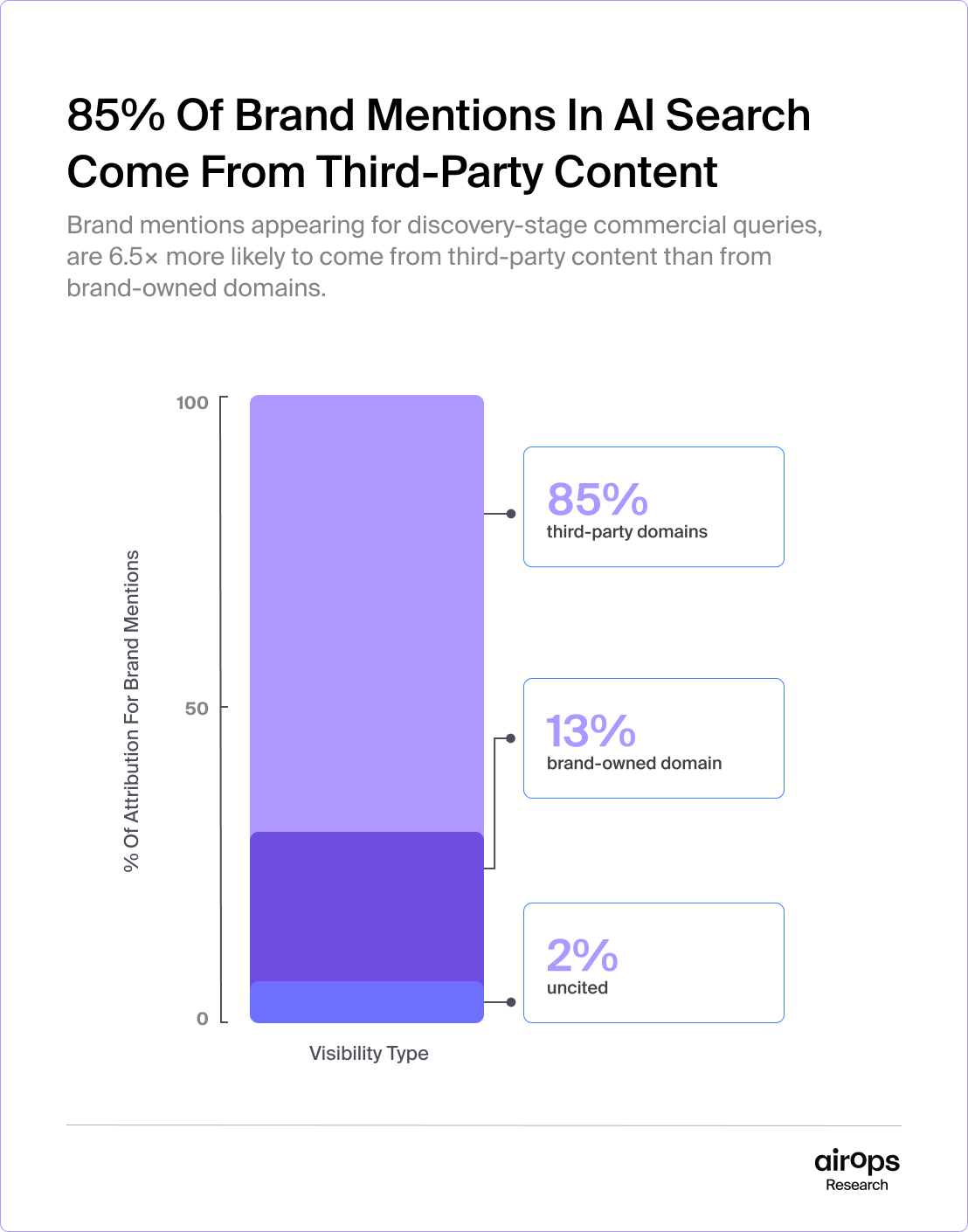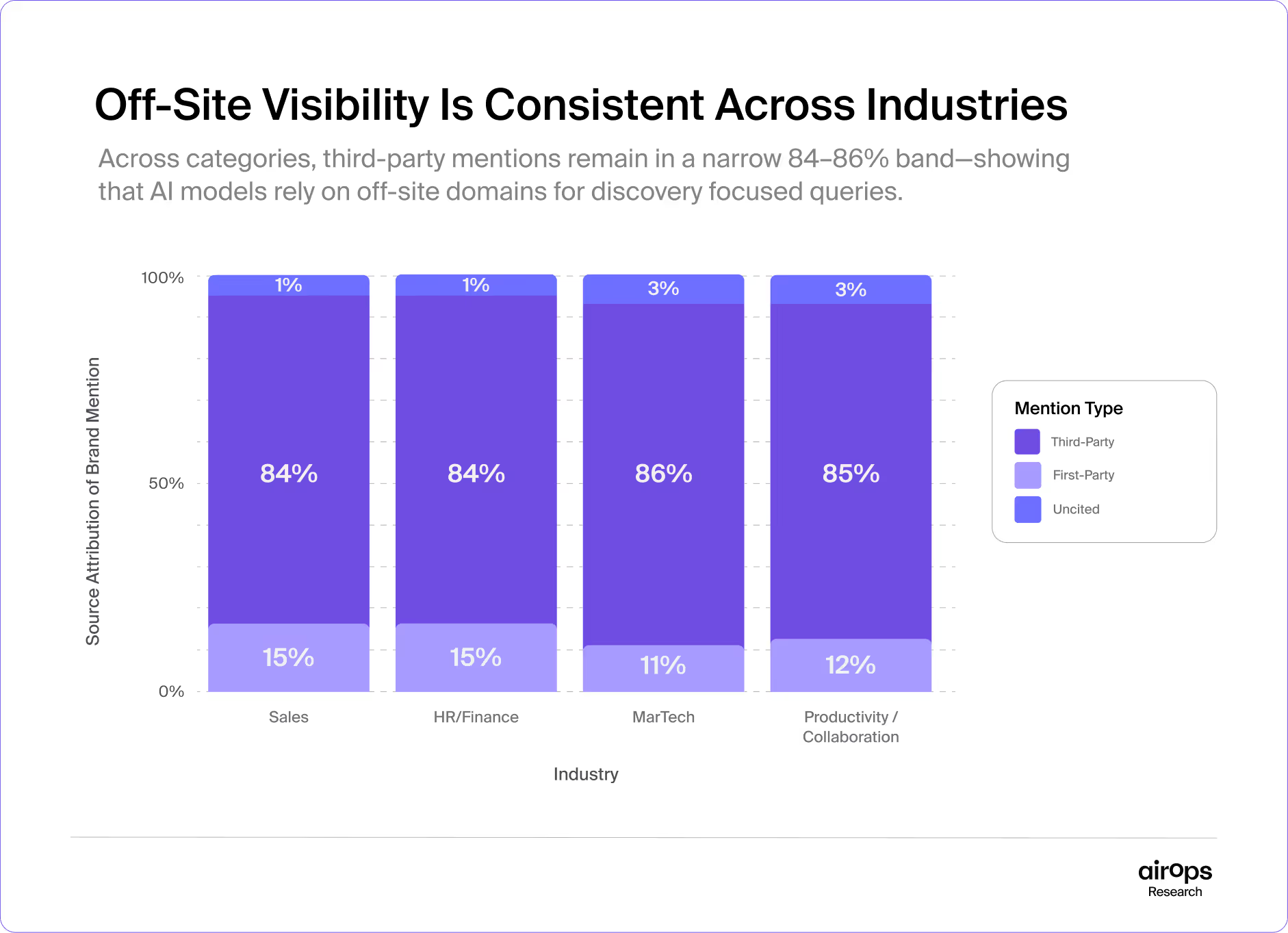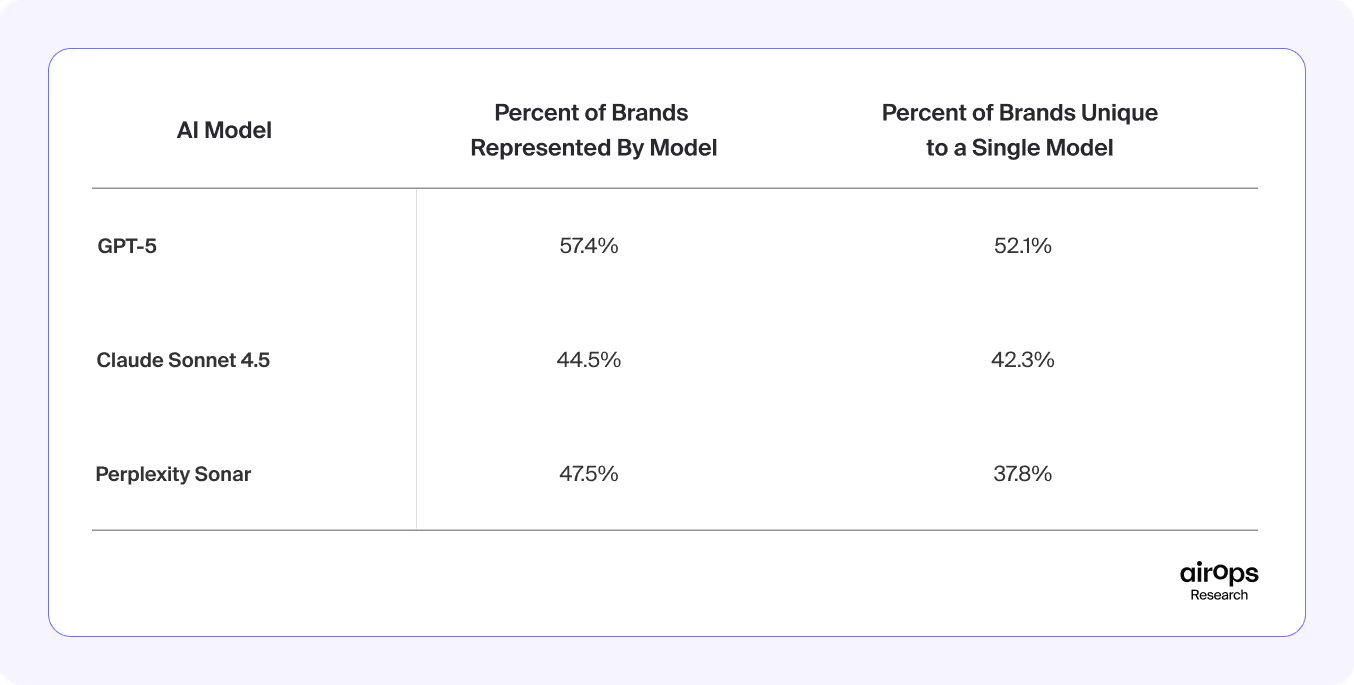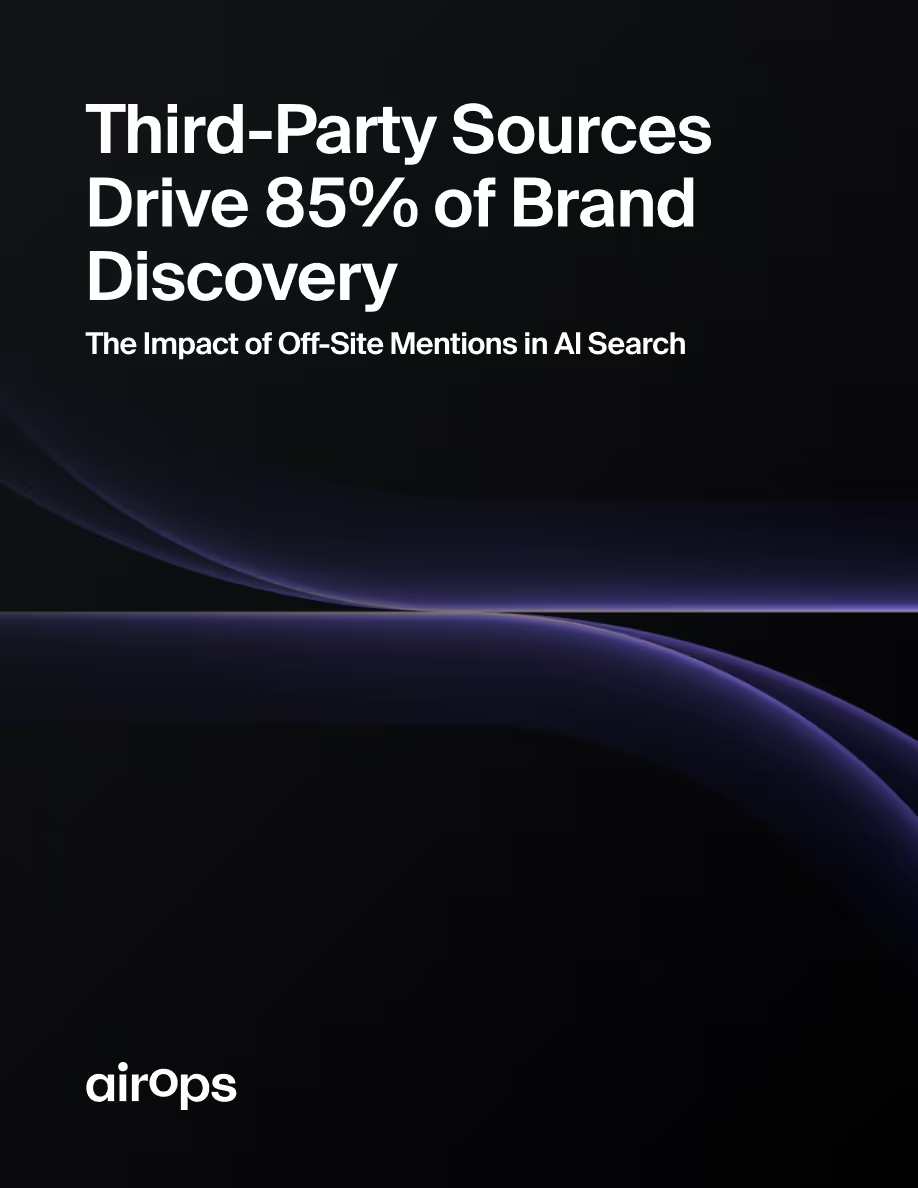Owned content is the baseline for earning visibility in AI search.
AI systems establish credibility through external recognition and consistent narratives across trusted sources. This validates what others say about a brand, not just what the brand says about itself.
Our analysis of 21,311 brand mentions across ChatGPT, Claude, and Perplexity found that brands mentioned in AI search for top-of-funnel commercial queries are 6.5x more likely to come from third-party content than the brand itself.
In this environment, owned and earned visibility must work together. Owned content provides the foundation of accuracy and authority, while third-party validation amplifies that credibility.
For marketing leaders, visibility in AI search now requires balancing on-site authority with off-site validation. The brands getting noticed aren’t the ones solely publishing the most. They’re the ones sharing ideas worth citing, starting conversations worth having, and showing expertise that spreads.
Check out our supplemental research on third-party sources, and learn how UGC and community platforms influence who wins in AI search.
Methodology
This study analyzed how AI search engines reference and surface brands in response to commercial-intent queries tied to brand discovery and early vendor evaluation—in top-of-funnel stages where users are exploring solutions, comparing options, or shortlisting vendors.
Our analysis examined over 500 commercial-intent queries across six verticals: MarTech, Sales, HR/Finance, and Productivity/Collaboration. The intent of these queries were focused on the discovery stage when users seek to understand which brands exist in a given category before purchasing decisions.
We tested each query across three leading AI platforms: GPT-5, Claude Sonnet 4.5, and Perplexity Sonar. Our goal was to see how each system attributes and surfaces brand visibility.
From these responses, we captured and classified the total brand mentions, identifying whether each was attributed to one of three source types:
First-party: Citations from a brand’s own domain.
Example: ChatGPT recommends HubSpot for “top sales CRM software” and cites hubspot.com as the source.
Third-party: Citations from an external domain.
Example: Perplexity mentions Asana for “best project management tools” and cites zapier.com/blog/best-project-management-tools as the source.
Uncited: Mentions that appeared without a visible citation (e.g., from training data or retrieved context not provided).
Example: Claude mentions “Asana is a leading project management tool” without providing any citation.
We analyzed patterns between brand visibility and citation type to better understand how authority and recognition shape brand discovery in AI search.
This research focuses on visibility during discovery and early vendor consideration. But owned content still matters. It builds credibility, drives conversion, and helps third-party sources find and describe your brand accurately.
Third-Party Sources Account for 85% of Brand Mentions in AI Search
Based on our analysis, when users use AI search for commercial discovery, the majority of brand mentions are attributed to third-party sources—outnumbering brand-owned citations by more than six to one.
Brands that build a strong owned-content foundation and earn external recognition increase their visibility in AI search.
Across all models analyzed, 85% of brand mentions came from external domains, while only 13.2% of mentions came directly from the brands domain.

AI visibility is shaped by external validation that builds on the foundation a brand creates through its own content and messaging. Brands consistently cited across trusted third-party sources gain clearer recognition in AI systems, which reinforces credibility beyond what’s published on their own domain.
While a small share of mentions (~2%) were uncited, these represent only baseline brand awareness. The real opportunity is to be cited in live web content, where AI systems pull from credible, up-to-date sources people trust when making decisions.
Trust works the same way online as it does in real life. Reputation grows when others validate your expertise. Brands that appear across respected third-party sites and publications strengthen the authority signals that AI systems rely on to determine which brands to surface.
When information about your brand is clear and trustworthy, others can reference it accurately—reinforcing visibility across both human and AI discovery.
Listicles Drive 9 in 10 Third-Party Mentions in AI Search
Listicles and industry roundups led as the core format for third-party visibility in AI search results, across top-of-funnel, discovery-phase commercial queries such as “best HR software,” “top CRM platforms,” or “best AI content generation platforms.”
Across the brands analyzed, nearly 90% of third-party mentions came from listicles, comparisons, or reviews. This shows that AI visibility often comes from outside validation, not just a brand’s own content.
Among these instances, 80% of brands often appeared as one of the first three companies discussed in the cited content. This suggests that higher placement in external content can increase the likelihood of being mentioned in relevant queries or within that content’s category context.
Product Pages and Homepages Drive 26% of First-Party Visibility in AI Search
While our analysis found that most brand mentions originate from third-party content, brand-owned pages still serve a critical role. They establish the facts and positioning that external sources build upon when discussing a brand, while also providing the detailed information answer engines rely on when user queries call for product-specific accuracy.
Among first-party mentions, product pages accounted for 19.3% of content and homepages another 7.1%, together representing more than a quarter of all first-party visibility.
AI models appear to reference brand domains when user intent shifts from exploration to verification—when queries imply “show me the details” rather than “who should I consider.”
These instances mark where owned content reinforces credibility and fills precision gaps that third-party coverage can’t.

When we analyzed the differences across categories, we found that brand mentions coming from owned content was generally higher in areas focused on product-specific detail (HR/Finance, Sales) and lower in broader, discovery-oriented categories (MarTech, Productivity/Collaboration).
These patterns suggest that AI systems tend to reference brands with clearer, more consistent messaging as signals of reliability.
Having a strong, unified brand narrative supported by detailed, accurate, and current product messaging ensures that when AI models reference a brand directly, they draw from a clear and reliable narrative.
That consistency builds trust as buyers evaluate options and helps keep your brand’s identity and authority aligned across every channel.
68% of Brand Mentions Are Often Unique to a Single AI Model
AI search visibility is highly variable across systems.
Each model we analyzed surfaced a distinct mix of brands, indicating meaningful differences in how they interpret authority, context, and entity relationships.
Across all models, nearly 68% of brands appeared in only one AI search platform, showing that each one pulls and interprets information differently. This makes a broad, diversified presence essential for visibility.
When we look within each model individually, between 37% and 52% of the brands it mentioned were exclusive to that platform. Each AI system constructs brand visibility through its own exposure patterns, data sources, and interpretation of authority.
This lack of overlap means brand recognition within AI ecosystems is still developing, and visibility is often dependent on how broadly a brand is referenced across external environments.

Each AI model recognizes brands differently. A brand might stand out in one system but be missing in another. The variation isn’t about relevance, but how each system interprets authority and recognition.
To improve visibility, brands need consistent presence across the web. Mentions in trusted sources—like industry sites, reviews, and user-generated content—reinforce credibility and strengthen both awareness and authority across AI systems.
Model Behavior Reinforces The Need for a Cohesive Strategy
When comparing categories and models, clear behavioral differences show why a cohesive visibility strategy matters.
Across all categories, models like Claude and Perplexity delivered the highest share of first-party mentions, ranging from 13% to 21%, reflecting a stronger tendency to reference brand-owned content when users seek specific product details or confirmation.
This reinforces the critical role lower-funnel content plays as a validation layer for brand credibility—ensuring owned assets remain visible and referenced as users progress from exploration to evaluation and purchase consideration.
In contrast, GPT-5 held the lowest range of first-party mentions (4%–11%), signaling a heavier reliance on aggregated third-party content across categories.
These differences reveal that when users turn to AI search, each model weighs on-site and off-site signals differently—but both matter.
For marketing leaders, visibility in AI search can’t depend solely on publishing more content or earning more mentions.
It comes from aligning the two: building clarity and authority through on-site content while reinforcing it through consistent, credible validation off-site.
To win visibility across AI systems, brands need to actively connect these channels, by treating on-site and off-site strategy as one integrated framework.
Brand Recognition Compounds When Owned and Earned Channels Align
Brands with both strong owned foundations and diverse earned recognition are better positioned to appear across AI search results.
When on-site and off-site channels work together, visibility doesn’t just add up—it amplifies. Owned content provides the depth AI systems draw from, while earned visibility signals validation and relevance across the broader ecosystem.

Owned content supplies the substance, and earned coverage carries those narratives into the spaces where discovery happens.
Earning that visibility takes more than outreach. It demands a clear market position and signals that make your brand memorable as the solution in its category.
When on-site and off-site efforts operate under a unified narrative, they create a compounding effect—each reinforcing and elevating the other over time; together, they enable brands to improve recognition and discoverability across the platforms and experiences where users search.
Strategic Implications for Marketing Leaders
Winning visibility in AI search isn’t about choosing between on-site authority or PR, it’s about aligning both. The brands winning are those that connect on-site authority with external validation that amplifies it.
Across 500+ commercial-intent queries, roughly 85% of brand visibility stemmed from third-party sources building on that owned foundation.
To stay competitive, marketing leaders must combine on-site authority with off-site validation:
1. Balance Visibility Efforts: Treat owned and earned strategies as complementary. Owned content establishes credibility and clarity; earned coverage extends it.
2. Design Content for Citation: Create original, fact-rich, authoritative content that others can easily reference.
3. Broaden Recognition Channels: Strengthen your presence in the channels and publications your buyers already rely on for credible insights.
4. Align Narrative Consistency: Keep messaging and proof points unified across channels.
Brands that don’t adapt to how buyers make decisions are already at risk.
As AI search accelerates, visibility will consolidate around brands with ideas that get cited widely. Marketing leaders who don’t integrate their owned and earned strategies risk disappearing from the early stages of the buyer journey altogether.
Your content needs gravity. These are ideas strong enough to be cited, repeated, and trusted across the web. The brands that master that balance will own AI visibility in 2026.
Ready to turn visibility into measurable growth?
Book a strategy session to learn how AirOps helps brands measure visibility and take action to win in AI search.

